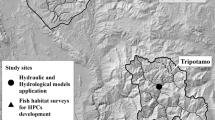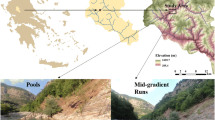Abstract
Climate change alters ecohydrological processes on different temporal and spatial scales. The aim of this study was to estimate ecological instream flow requirements (EIFR) under climate change impacts and to ascertain optimum flow magnitude to maintain the health of river ecosystems. We used the Mann–Kendall test, the River2D Hydrodynamic model, and the frequency-weighted usable area (FWUA) model on an annual scale in the Juma River to investigate changes in EIFRs caused by climate change. Findings indicated that: (1) between 1956 and 2005, annual instream flow in the Juma River exhibited an abrupt downward trend (in 1981); (2) variation in instream flow governed the area of available fish habitat, and degrees of change for low flow threshold values and low and high FWUA threshold almost exclusively occurred in descending sequential order from winter, spring, autumn, and summer; (3) changes in hydrological regimes influenced both the quantity and quality of physical habitat area, contributing greater to quality than to the distribution of area of physical habitat for Pseudorasbora parva. Climate change, reflected in the changes in EIFR and the area of optimum physical habitat, has dramatically influenced ecological structure and function, even in the small river system investigated for this study. Findings indicated that more rational measures should be put into practice to help address climate change.








Similar content being viewed by others
References
Abbaspour M, Javid AH, Mirbagheri SA, Givi FA, Moghimi P (2012) Investigation of lake drying attributed to climate change. Int J Environ Sci Technol 9(2):257–266
Acreman MC, Dunbar MJ (2004) Defining environmental river flow requirements—A review. Hydrol Earth Syst Sci Discuss 8(5):861–876
Bao ZX, Zhang JY, Wang GQ, Fu GB, He RM, Yan XL, Jin JL, Liu YL, Zhang AJ (2012) Attribution for decreasing streamflow of the Haihe River basin, northern China: climate variability or human activities? J Hydrol 460:117–129
Barranco LM, Javier AR, Olivera F, Olivera A, Quintas L, Estrada F (2013) Assessment of the expected runoff change in Spain using climate simulations. J Hydrol Eng 19(7):1481–1490
Bovee KD (1982) A guide to stream habitat analysis using the instream flow incremental methodology. Fish and Wild life Service, Washington, DC
Bovee KD (1986) Development and evaluation of habitat suitability criteria for use in the instream flow incremental methodology. Washington, DC: USDI Fish and Wildlife Service. Instream flow information paper no. 21 FWS/OBS/86/7. http://www.fort.usgs.gov/Products/Publications/pub_abstract.asp?PubID=1183
Campos GEP, Moran MS, Huete A, Zhang YG, Bresloff C, Huxman TE, Eamus D, Bosch DD, Buda AR, Gunter SA, Scalley TH, Kitchen SG, McClaran MP, McNab WH, Montoya DS, Morgan JA, Peters DPC, Sadler EJ, Seyfried MS, Starks PJ (2013) Ecosystem resilience despite large-scale altered hydroclimatic conditions. Nature 494:349–352
Chen FL, Wang J, Yang G, Jia XJ (2010) Analysis of the rainfall and runoff change trend in the Zijingguan basin. J Shihezi U (Nat. Sci.) 28(1):101–105 (in Chinese with English abstract)
Clark JS, Rizzo DM, Watzin MC, Hession WC (2008) Statial distribution and geomorphic condition of fish habitat in streams: an analysis using hydraulic modelling and geostatistics. River Res Appl. 24(7):885–899
Cui BS, Hua YY, Wang CF, Liao AL, Tan XJ, Tao WD (2010) Estimation of ecological water requirements based on habitat response to water level in Huanghe River Delta, China. Chin Geogr Sci 20(4):318–329
Daniel C, Nassir EJ (1994) Comparison and regionalization of hydrologically based instream flow techniques in Atlantic Canada. Can J Civ Eng 22(2):235–246
Dindaroğlu T, Reis M, Akay AE, Tonguc F (2015) Hydroecological approach for determining the width of riparian buffer zones for providing soil conservation and water quality. Int J Environ Sci Technol 12(1):275–284
Ghanem A, Steffler PM, Hicks FE, Katopodis C (1995) Dry area treatment for two-dimensional finite element shallow flow modelling. In: Proceedings of the Canadian Hydrotechn
Gibson CA, Meyer JL, Poff NL, Hay LE, Georgakakos A (2005) Flow regime alterations under changing climate in two river basins implications for freshwater ecosystems. River Res Appl 21:849–864
Gong AX, Zhang DD, Feng P (2012) Variation trend of annual runoff coefficient of Daqinghe River Basin and study on its impact. Water Res Hydrop Eng 43(6):1–4 (in Chinese with English abstract)
Hamilton SK (2002) Hydrological controls of ecological structure and function in the Pantanal wetland (Brazil). In: McClain M (ed) The ecohydrology of South American Rivers and Wetlands, vol 6. International Association of Hydrological Sciences, Wallingford, pp 133–158
Hayes JW, Hughes NF, Kelly LH (2007) Process-based modelling of invertebrate drift transport, net energy intake and reach carrying capacity for drift-feeding salmonids. Ecol Mod 207:171–188
Huckstorf V, Lewin WC, Wolter C (2008) Environmental flow methodologies to protect fisheries resources in human-modified large lowland rivers. River Res Appl 24(5):519–527
IPCC (2007) Climate change 2007: the physical science basis. In: Solomon S et al (eds) Contribution of working group I to the fourth assessment report of the intergovernmental panel on climate change. Cambridge University Press, Cambridge
Ji ZH, Yang CX, Qiao GJ (2010) Reason analysis and calculation of surface runoff rapid decrease in the Northern branch of Daqinghe River. South North Water Transf Water Sci Tech 2(8):73–76
Jiang XH, Zhao WH, Zhang WG (2010) The impact of Xiaolangdi Dam operation on the habitat of Yellow River Carp (Cyprinus (Cyprinus) carpio haematopterus Temminck et Schlegel). Acta Ecol Sin 302(18):4941–4947
Karimi SS, Yasi M, Eslamian S (2012) Use of hydrological methods for assessment of environmental flow in a river reach. Int J Environ Sci Technol 9(3):549–558
Kendall MG (1948) Rank correlation methods. Hafner, New York
Kozarek JL, Hession WC, Dolloff CA, Diplas P (2014) Hydraulic complexity metrics for evaluating in-stream brook trout habitat. J Hydraul Eng 136(12):1067–1076
Leclerc M, Boudreault A, Bechara JA, Corfa G (1995) Two-dimensional hydrodynamic modeling: a neglected tool in the instream flow incremental methodology. Trans Am Fish Soc 124:645–662
Lee JH, Kil JT, Jeong S (2010) Evaluation of physical fish habitat quality enhancement designs in urban streams using a 2D hydrodynamic model. Ecol Eng 36:1251–1259
Liang LQ, Li LJ, Liu Q (2011) Precipitation variability in Northeast China from 1961 to 2008. J Hydrol 404:67–76
Liu Q, Cui BS (2011) Impacts of climate change/variability on the streamflow in the Yellow River Basin, China. Ecol Mod 222:268–274
Liu Q, Yang ZF, Cui BS (2008) Spatial and temporal variability of annual precipitation during 1961–2006 in Yellow River Basin, China. J Hydrol 361:330–338
Mann HB (1945) Non-parametric test against trend. Econometrika 13:245–259
Milhous RT, Updike MA, Schneider DM (1989) Physical habitat simulation system reference manual-version II. Biological report
Parasiewicz P, Castelli E, Rogers JN, Plunkett E (2012) Multiplex modelling of physical habitat for endangered freshwater mussels. Ecol Mod 228:66–75
Peñas FJ, Juanes JA, Álvarez-Cabria M, Álvarez C, García A, Puente A, Barquín J (2014) Integration of hydrological and habitat simulation methods to define minimum environmental flows at the basin scale. Water Environ J 28(2):252–260
Piniewski M, Laizé CLR, Acreman M, Schneider C (2014) Effect of climate change on environmental flow indicators in the Narew Basin, Poland. J Environ Qual 43(1):155–167
Poff NL (2002) Ecological response to and management of increased flooding caused by climate change. Philos Trans R Soc Lond Ser A Math Phys Eng Sci 360(1796):1497–1510
Richter BD, Baumgartner JV, Powell J, Braun D (1996) A method for assessing hydrologic alteration within ecosystems. Conservat. Boil 10(4):1163–1174
Ruiz F, Abad M, Bodergat AM, Carbonel P, Rodriguez-Lazaro J, Gonzalez-Regalado ML, Toscano A, Garcia EX, Prenda J (2013) Freshwater ostracods as environmental tracers. Int J Environ Sci Technol 10(5):1115–1128
Ryberg KR, Lin W, Asce M, Vecchia AV (2012) Impact of climate variability on runoff in the North-Central USA. J Hydrol Eng 19(1):148–158
Shokoohi A, Amini M (2014) Introducing a new method to determine rivers’ ecological water requirement in comparison with hydrological and hydraulic methods. Int J Environ Sci Technol 11(3):747–756
Song JX, Xu ZX, Liu CM, Li HE (2007) Ecological and environmental instream flow requirements for the Wei River—the largest tributary of the Yellow River. Hydrol Proc 21(8):1066–1073
Steffler P, Blackburn J (2002) Two-dimensional depth averaged model of river hydrodynamics and fish habitat: introduction to depth averaged modeling and user’s manual. University of Alberta
Sun JN, Zhang TQ, Zhu D, Fu J (2013) Simulative evaluation of fish habitat of backwater tributary of Baihetan Reservoir. Water Resour Hydropower Eng 44(10):17–22 (in Chinese with English abstract)
Tan YP, Wang YR, Li J, Liu M (2011) Simulation research on fish habitats in reducing reach of Jinping Dahewan in Yalong River. Water Resour Power 29(3):40–43 (in Chinese with English abstract)
Tennant DL (1976) Instream flow regimens for fish, wildlife, recreation, and related environmental resources. Am Fish Soc 1:6–10
Tharme RE (2003) A global perspective on environmental flow assessment: emerging trends in the development and application of Environmental flow methodologies for rivers. River Res Appl 19:397–441
Tian YY, Wang X, Li CH, Can YP, Yang ZF, Wang YL (2012) Estimation of ecological flow requirement in Zoige Alpine Wetland of southwest China. Environ Earth Sci 66(5):1525–1533
Waddle T, Steffler PM, Ghanem A, Katopodis C, Locke A (1996) Comparison of one and two dimensional hydrodynamic models for a small habitat stream. Ecohydr. Conf., p 10
Wang YK, Xia ZQ, Wang D (2011) Assessing the effect of separation levee project on Chinese sturgeon (Acipenser sinensis) spawning habitat suitability in Yangtze River, China. Aquat Ecol 45(2):255–266
Wang XN, Liu ZT, Yan ZG, Zhang C, He L, Meng SS (2013) Species sensitivity evaluation of Pseudorasbora parva. Environ Sci 34(6):2329–2334 (in Chinese with English abstract)
Xu LJ (2011) Analysis on dynamic feature of the rainfall-runoff relationship in the Daqing river basin under the influence of human activities. South North Water Transf Water Sci Technol 9(2):73–76 (in Chinese with English abstract)
Xu XL, Zhang CJ, Wu JF, Feng ZJ (2012) Study on the tolerance of salinity and pH in the fish, Pseudorasbora parva. Hubei Agric Sci 51(7):1423–1425 (in Chinese with English abstract)
Yan Y, Yang ZF, Liu Q (2013) Nonlinear trend in streamflow and its response to climate change under complex ecohydrological patterns in the Yellow River basin, China. Ecol Mod 252:220–227
Yang ZF, Cui BS, Liu JL, Wang XQ, Liu CM (2003) Theory, method and practice of ecological environmental water requirement. Science Press, Beijing
Yang ZF, Yu SW, Chen H, She DX (2010) Model for defining environmental flow thresholds of spring flood period using abrupt habitat change analysis. Adv Water Sci 21(4):567–574 (in Chinese with English abstract)
Yang ZF, Liu Q (2011) Response of streamflow to climate changes in the Yellow River Basin, China. J Hydrometeorol 12(5):1113–1126
Yang Z, Yan Y, Liu Q (2012) Assessment of the flow regime alterations in the lower yellow river, China. Ecol Inform 10(7):56–64
Yang K, Zhu DM, Wang WM (2013) Oxygen consumption rate and asphyxia point in Topmouth Gudgeon, Pseudorasbora parva. Fisher Sci 32(5):256–260 (in Chinese with English abstract)
Yuan F, Xie ZH, Ren LL, Huang Q (2005) Hydrological variation in Haihe River Basin due to climate change. J Hydraul Eng 36(3):274–279
Zeng Y (2012) Morphometrics analysis of the invasive Pseudorasbora parva from different habitats. J Hydroecol 33(2):115–120 (in Chinese with English abstract)
Zhao JY, Dong ZR, Sun DY (2008) State of the art in the field of River habitat assessment. Sci Technol Rev 26(17):82–88 (in Chinese with English abstract)
Zhong HP, Liu F, Geng LH, Xu CX (2006) Review of assessment methods for instream flow requirements. Adv Water Sci 17(3):430–434 (in Chinese with English abstract)
Acknowledgements
This study was supported by the National Natural Science Foundation of China (No. 51579008), the National Key Basic Research and Development Project (2016YFC0500402), the special fund of the State Key Joint Laboratory of Environment Simulation and Pollution Control (14L01ESPC), and the Open Research Fund Program of the Beijing Climate Change Response Research and Education Center (Beijing University of Civil Engineering and Architecture).
Funding was provided by the Beijing Higher Education Young Elite Teacher Project (Grant No. YETP0259).
Author information
Authors and Affiliations
Corresponding author
Additional information
Editorial responsibility: Tan Yigitcanlar.
Rights and permissions
About this article
Cite this article
Liu, Q., Yu, H., Liang, L. et al. Assessment of ecological instream flow requirements under climate change Pseudorasbora parva . Int. J. Environ. Sci. Technol. 14, 509–520 (2017). https://doi.org/10.1007/s13762-016-1166-1
Received:
Revised:
Accepted:
Published:
Issue Date:
DOI: https://doi.org/10.1007/s13762-016-1166-1




